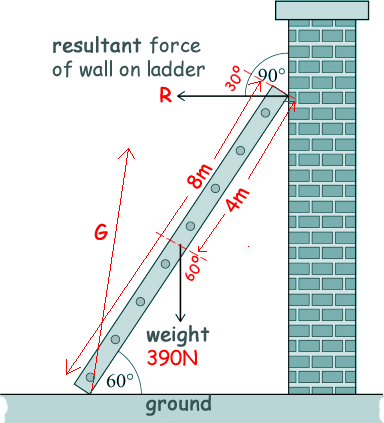Forces in Equilibrium - Statics Q1. The diagram shows two of the forces acting on a uniform ladder resting against a vertical wall. The ladder is at an angle of 60° to the ground.
(a) Explain how the diagram shows that the friction between the ladder and the wall is negligible. Friction, if present, would be drawn as acting along the wall. The resultant force is drawn as perpendicular to the wall - so no component can be present acting along the wall. [1 mark] (b) The forces acting on the ladder are in equilibrium. Draw an arrow on the diagram to show the direction of the resultant force from the ground acting on the ladder. Label your arrow G.
[2 marks] (c) The ladder is 8.0 m long and weighs 390 N. Calculate the magnitude of the resultant force from the wall on the ladder. Centre of gravity of ladder is 4m from the ends - see diagram. Taking moments about end on ground:
sum of clockwise moments = sum of anticlockwise moments 390 cos 60o x 4 = R cos 30o x 8 R = 195 x cos 60o/cos 30o R = 113 N [2 marks] (d) Suggest the changes to the forces acting on the ladder that occur when someone climbs the ladder. ANY 3
[3 marks] (8 marks Total) |
Follow me...
|






